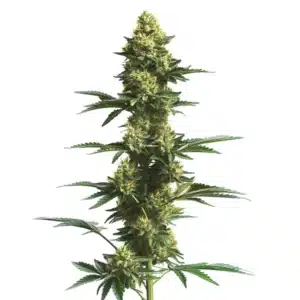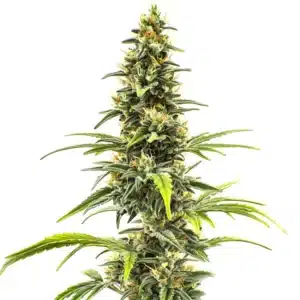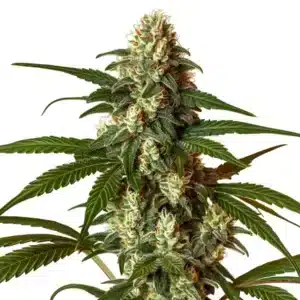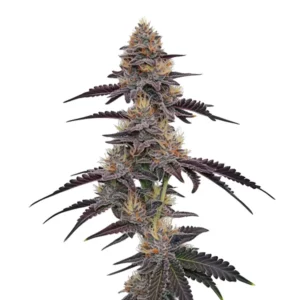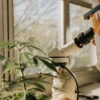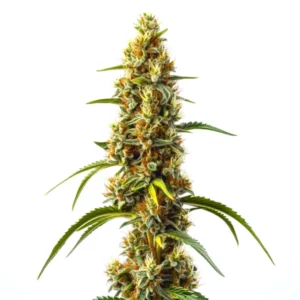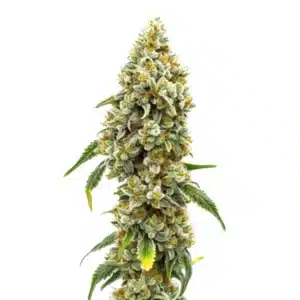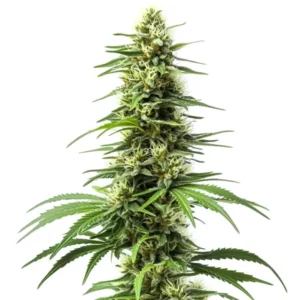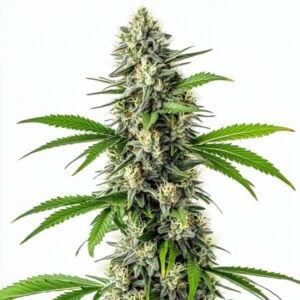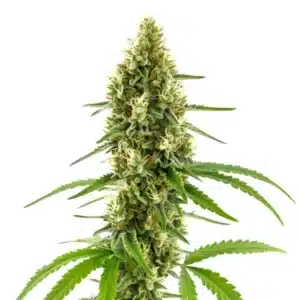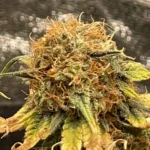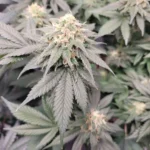
How to Grow Fruit Strain CBD
Fruit Strain CBD Description
Fruit Strain CBD, also known as CBD Fruit (1:25), is a fast flowering cannabis variety that offers a strong and relaxing experience with a good dose of energy. It has very low THC levels, ranging from 0.1% to 0.2%, and contains medium levels of CBD between 12% and 14%. The genetics are a cross of C99 x Sativa and the strain is classified as CBD. With a composition of 60% Indica and 40% Sativa, it is mostly Indica, which contributes to its calming and therapeutic properties.
The buds are moderately dense and resinous, and the strain produces medium yields. Expect yields of 1.47 to 1.64 oz/ft² (450 to 500 gr/m²) and per plant yields between 14 and 17 oz (400 to 500 grams). The plant grows to about 4.92 ft (1.5 m) in height and has a flowering period of 8 to 10 weeks. Fruit Strain CBD is suitable for all seasons and ideal for beginners. It is used to help relieve arthritis, insomnia, and pain.
Recommended Strains
CBD Fruit (1:25)
|
|
CBD | 12% – 14% (Medium) |
|
|
Type | CBD Feminized |
|
|
Yield | Medium |
|
|
Phenotype | 60% Indica / 40% Sativa |
Sour Tsunami
|
|
THC | 7% - 10% (Low) |
|
|
Type | Feminized |
|
|
Yield | Medium |
|
|
Phenotype | 40% Indica / 60% Sativa |
The terpene profile is complex. For arthritis relief, Delta 3 Carene and Linanool help reduce symptoms while Alpha-Pinene and Beta-Pinene are beneficial for arthritis, asthma, and anti-inflammatory issues. For a sleepy effect, Myrcene, Terpineol and a high percentage of Linalool produce a calm and sedative state. In cases of pain, Myrcene and Humulene trigger pain reduction and when Eucalyptol is present, it aids in relieving chronic pain. The aromas are spicy, floral, lavender, mint, cinnamon, cilantro, woody, and pine. Overall, Fruit Strain CBD produces creative, energetic, and uplifted effects along with a pleasant flavor profile that includes apple, berry, citrus, sweet, and tropical notes.
Promos & Deals
Growing Environment
Fruit Strain CBD thrives in a stable and well-regulated environment. Indoor growers should maintain daytime temperatures between 70°F and 80°F (21°C to 27°C) and allow slightly cooler nights to support proper bud development. During the vegetative phase, humidity should be kept between 60% and 70% and reduced to 40% to 50% during flowering to prevent mold and to enhance resin production. Use quality LED or HPS lights by providing 18 to 20 hours of light during early growth and switch to a 12/12 light and dark cycle once flowering begins.
For outdoor cultivation, choose a sunny location with well-draining, nutrient-rich soil. Enrich the soil with compost or worm castings to boost fertility. Protect the plants from strong winds using basic barriers and monitor environmental conditions closely. Active adjustments to temperature, light, and humidity are essential for a successful harvest.
Setting Up Your Grow Space
Fruit Strain CBD Description Indoor Cultivation
Create a dedicated indoor grow space using a grow tent or small room with reflective walls to distribute light evenly. Install oscillating fans and an exhaust system with a carbon filter to control heat and odor. Start Fruit Strain CBD in small pots filled with high-quality soil and maintain a pH between 6.0 and 6.5. Transplant the seedlings into larger containers as they grow to allow ample root space.
This controlled setup lets you monitor and adjust conditions actively so that your plants develop strong and healthy, ready for a smooth flowering phase.
Fruit Strain CBD Description Outdoor Cultivation
Select a location with full sun exposure and prepare the soil by mixing in organic matter such as compost or worm castings. Using raised beds or large containers can improve drainage and soil quality. Install simple windbreaks to protect your plants from gusty winds. Regular watering and routine maintenance such as weed removal help maintain a fertile environment.
Active outdoor care will ensure that Fruit Strain CBD grows naturally and produces a bountiful yield while keeping the plants healthy and robust.
Seed Propagation and Germination
Begin with high-quality feminized seeds of Fruit Strain CBD from a trusted supplier. Soak the seeds in distilled water or place them on a damp paper towel for 24 to 48 hours to soften the seed coat and trigger the taproot. When a small taproot appears, plant the seed in a container with light, well-draining soil.
Maintain temperatures between 75°F and 80°F (24°C to 27°C) and humidity around 60% to 70% until the seedlings develop their first true leaves. Gradually increase light intensity as the plants grow. These careful steps provide a strong foundation for vigorous development throughout the growth cycle.
Fruit Strain CBD Description Vegetative Phase
During the vegetative phase, Fruit Strain CBD grows rapidly and builds a sturdy structure. Provide 18 to 20 hours of light per day to encourage robust leaf and stem development. Use a nitrogen-rich fertilizer to support healthy growth. Active training techniques such as low-stress training (LST) or topping help create an even canopy, ensuring that light reaches every part of the plant.
Monitor temperature, humidity, and watering closely. Consistent care during this phase prepares the plants for a smooth transition into flowering, which is essential for producing dense and high-quality buds.
Fruit Strain CBD Description Flowering Phase
When it is time to flower, adjust your light cycle to 12 hours on and 12 hours off. During this stage, Fruit Strain CBD directs its energy into producing thick, resinous buds that encapsulate its unique flavor of apple, berry, citrus, sweet, and tropical notes. Feed the plants with fertilizers high in phosphorus and potassium to boost bud development.
Keep temperatures cooler (65°F to 75°F) and humidity lower (40% to 50%) to prevent mold and maximize resin production. Provide support for heavy branches with stakes or trellises if needed. Inspect the buds regularly with a magnifier and harvest when most trichomes appear milky with hints of amber. This attentive approach ensures a premium yield.
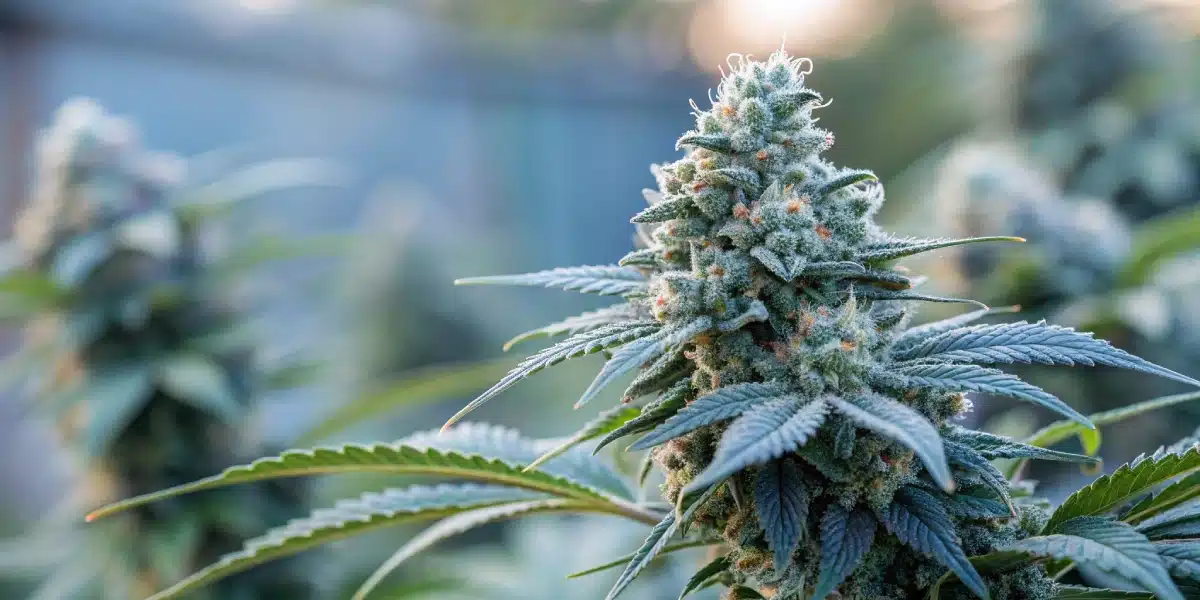
Fertilization and Nutrition
Proper feeding is key to a successful Fruit Strain CBD crop. Begin with a nitrogen-rich fertilizer during the vegetative stage to promote robust foliage, then transition to a blend high in phosphorus and potassium during flowering to support bud growth. Keep the pH steady between 6.0 and 6.5 for optimal nutrient absorption. Many growers enhance soil quality by adding organic supplements such as compost or worm castings, which boost both yield and flavor.
Regularly review your watering schedule and adjust nutrient doses as needed. Active nutrient management ensures that your plants remain healthy and productive throughout their life cycle.
Pest and Disease Control
Maintain a clean grow space and inspect your Fruit Strain CBD plants daily for pests such as spider mites, aphids, or thrips. Use organic treatments like neem oil at the first sign of infestation. Ensure good airflow and promptly remove any dead leaves to reduce the risk of fungal diseases. If mold or mildew appears, remove the affected areas immediately and adjust humidity levels.
Quick and active responses to pest or disease issues are essential for maintaining plant health and ensuring a successful harvest.
Fruit Strain CBD Description Harvesting and Curing
Harvest Fruit Strain CBD when most trichomes turn milky with hints of amber. Use clean, sharp tools to carefully cut the branches. Dry the buds in a dark, well-ventilated area where temperatures remain between 60°F and 70°F, ensuring ample space for air circulation.
After drying, cure the buds in airtight glass jars. Open the jars daily during the first week to release excess moisture, then allow the buds to cure for 2 to 4 weeks. This curing process refines the flavor and potency of Fruit Strain CBD while preserving its unique aroma and therapeutic effects.
Fruit Strain CBD Description Indica or Sativa?
Fruit Strain CBD is mostly Indica, with a composition of 60% Indica and 40% Sativa. This genetic makeup provides a strong and relaxing experience that is effective for reducing pain, alleviating insomnia, and easing arthritis symptoms. It delivers a calming effect that helps restore balance and energy without heavy sedation.

Advantages and Disadvantages
Advantages: Fruit Strain CBD produces aromatic, resinous buds with a delightful blend of apple, berry, citrus, sweet, and tropical flavors. It offers medium yields and a fast flowering time of 8 to 10 weeks. Its low THC and medium CBD levels provide a therapeutic, relaxing experience that is ideal for beginners and effective for treating arthritis, insomnia, and pain.
Disadvantages: The low THC content may not satisfy those seeking a more psychoactive effect. Additionally, careful nutrient and environmental management is required to preserve its delicate flavor profile and therapeutic properties.
Why Buy Fruit Strain CBD
Choose Fruit Strain CBD if you desire a cannabis variety that offers a strong, relaxing experience combined with therapeutic benefits. Its balanced, mostly Indica profile is perfect for managing arthritis, insomnia, and pain while delivering a calming effect. Ideal for beginners, this strain offers medium yields, a fast flowering time, and a unique flavor profile that includes apple, berry, citrus, sweet, and tropical notes.
Common Growing Problems
Watch for nutrient imbalances, improper watering, and pest infestations. Overfeeding, underwatering, or neglecting environmental controls can stress your plants. Regular monitoring and prompt corrective actions are necessary to keep your Fruit Strain CBD crop healthy and productive throughout its growth cycle.
Similar Strains
Harlequin: Harlequin is known for its high CBD and low THC content. It offers a mellow, clear-headed experience with a distinct earthy and herbal flavor. It is popular among growers looking for therapeutic effects without strong psychoactive impact.
Cannatonic: Cannatonic is celebrated for its balanced CBD to THC ratio. It provides a gentle, relaxing high along with a subtle, pleasant flavor profile that combines earthy and citrus notes. It is often used for medicinal purposes.
Sour Tsunami: Sour Tsunami is one of the first CBD-dominant strains, offering a calming experience with a slight tangy flavor. It is favored for its effectiveness in pain relief and stress reduction while maintaining a clear, functional high.
Tips for Professionals
For experienced growers, fine-tuning every detail is essential. Use timers and quality sensors to maintain consistent light cycles, temperature, and humidity. Keep detailed records of nutrient adjustments, watering schedules, and environmental changes to quickly identify issues and apply active corrections. Incorporate organic supplements and microbial inoculants to enhance soil health and nutrient uptake. Experiment with advanced training techniques and monitor plant responses to refine your methods. A proactive, hands-on approach combined with modern technology will help you consistently achieve premium yields with Fruit Strain CBD.
FAQs
What makes Fruit Strain CBD unique?
Fruit Strain CBD stands out because of its very low THC and medium CBD levels, which deliver a strong and relaxing experience. Its unique flavor profile of apple, berry, citrus, sweet, and tropical notes, along with its therapeutic benefits for arthritis, insomnia, and pain, make it an excellent choice for those seeking a medicinal yet uplifting strain.
How long is the flowering period?
The flowering period for Fruit Strain CBD typically lasts between 8 and 10 weeks. During this time, the buds develop a dense, resinous structure and reach their peak potency as the trichomes turn milky with hints of amber.
Can I grow Fruit Strain CBD outdoors?
Yes, Fruit Strain CBD thrives outdoors when planted in a sunny location with well-draining, nutrient-rich soil. Consistent care, proper watering, and wind protection help the plants produce a rewarding yield.
What nutrients does Fruit Strain CBD need?
During the vegetative stage, use a nitrogen-rich fertilizer to promote strong foliage. When flowering, switch to a blend high in phosphorus and potassium to support bud growth. Maintaining a pH between 6.0 and 6.5 is crucial for effective nutrient absorption.


